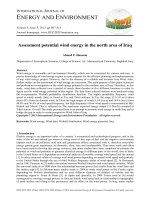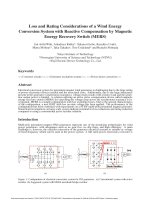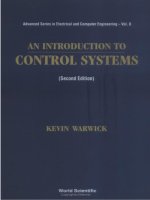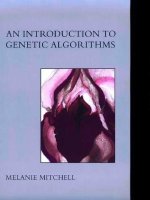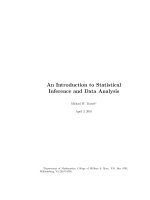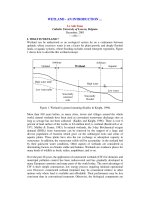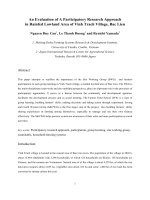wind-energy-an-introduction-mohamed-a-el-sharkawi-crc-2016
Bạn đang xem bản rút gọn của tài liệu. Xem và tải ngay bản đầy đủ của tài liệu tại đây (20.2 MB, 345 trang )
Wind Energy
El-Sharkawi
Engineering – Electrical
AN INTRODUCTION
Wind Energy: An Introduction covers wind energy system types, operation,
modeling, analysis, integration, and control. Beginning with a history of the
development of wind energy, this comprehensive book:
WIND ENERGY
• Explains the aerodynamic theories that govern the operation of
wind turbines
• Presents wind energy statistics to address the stochastic nature
of wind speed
• Employs the statistical modeling of wind speed to evaluate sites for
wind energy generation
• Highlights the differences between the most common types of
wind turbines
• Analyzes the main power electronic circuits used in wind energy
• Details the induction, synchronous, and permanent magnet generators
from the basic principle of induced voltage to the steady-state
and dynamic models
• Explores the operation, stability, control, and protection of type
1, 2, 3, and 4 wind turbines
• Discusses the main integration challenges of wind energy systems
with electric utility systems
• Features numerous models, illustrations, real-world examples,
and exercise problems
• Includes a solutions manual and figure slides with qualifying
course adoption
Wind Energy: An Introduction requires a basic knowledge of electric circuit
theory, making it an ideal text for students at the senior-undergraduate and
graduate levels. In addition, the book provides practicing engineers with a
handy professional reference.
K24400
ISBN: 978-1-4822-6399-2
90000
9 781482 263992
AN INTRODUCTION
Mohamed A. El-Sharkawi
Wind
Energy
AN INTRODUCTION
Wind
Energy
AN INTRODUCTION
Mohamed A. El-Sharkawi
UNIVERSITY OF WASHINGTON, SEATTLE, USA
Boca Raton London New York
CRC Press is an imprint of the
Taylor & Francis Group, an informa business
CRC Press
Taylor & Francis Group
6000 Broken Sound Parkway NW, Suite 300
Boca Raton, FL 33487-2742
© 2016 by Taylor & Francis Group, LLC
CRC Press is an imprint of Taylor & Francis Group, an Informa business
No claim to original U.S. Government works
Version Date: 20141017
International Standard Book Number-13: 978-1-4822-6400-5 (eBook - PDF)
This book contains information obtained from authentic and highly regarded sources. Reasonable efforts have been
made to publish reliable data and information, but the author and publisher cannot assume responsibility for the validity of all materials or the consequences of their use. The authors and publishers have attempted to trace the copyright
holders of all material reproduced in this publication and apologize to copyright holders if permission to publish in this
form has not been obtained. If any copyright material has not been acknowledged please write and let us know so we may
rectify in any future reprint.
Except as permitted under U.S. Copyright Law, no part of this book may be reprinted, reproduced, transmitted, or utilized in any form by any electronic, mechanical, or other means, now known or hereafter invented, including photocopying, microfilming, and recording, or in any information storage or retrieval system, without written permission from the
publishers.
For permission to photocopy or use material electronically from this work, please access www.copyright.com (http://
www.copyright.com/) or contact the Copyright Clearance Center, Inc. (CCC), 222 Rosewood Drive, Danvers, MA 01923,
978-750-8400. CCC is a not-for-profit organization that provides licenses and registration for a variety of users. For
organizations that have been granted a photocopy license by the CCC, a separate system of payment has been arranged.
Trademark Notice: Product or corporate names may be trademarks or registered trademarks, and are used only for
identification and explanation without intent to infringe.
Visit the Taylor & Francis Web site at
and the CRC Press Web site at
To wind energy researchers and developers for their visions and tenacity to pursue
the technology even when renewable energy was unrealistically expensive
To my wife Fatma and sons Adam and Tamer
Contents
Preface............................................................................................................................................ xiii
Author..............................................................................................................................................xv
List of Variables........................................................................................................................... xvii
1. History of the Wind Energy Development......................................................................... 1
1.1 Wind Turbines................................................................................................................4
1.2 Offshore Wind Turbines................................................................................................8
Exercise....................................................................................................................................... 9
2. Aerodynamics of Wind Turbines....................................................................................... 11
2.1 Wind Speed................................................................................................................... 14
2.1.1 Impact of Friction and Height on Wind Speed........................................... 14
2.1.2 Air Density...................................................................................................... 16
2.2 WT Blades..................................................................................................................... 18
2.2.1 Angle of Attack............................................................................................... 19
2.2.2 Relative Wind Speed......................................................................................22
2.2.3 Pitch Angle....................................................................................................... 24
2.3 Coefficient of Performance......................................................................................... 24
2.3.1 Tip-Speed Ratio...............................................................................................30
2.3.2 Blade Power..................................................................................................... 31
2.4 Separation of WTs........................................................................................................ 35
Exercise..................................................................................................................................... 40
3. Wind Statistics.......................................................................................................................43
3.1 Average Variance and Standard Deviation..............................................................44
3.2 Cumulative Distribution Function............................................................................ 46
3.3 Probability Density Function..................................................................................... 47
3.3.1 Weibull Distribution Function...................................................................... 48
3.3.2 Rayleigh Distribution Function.................................................................... 50
3.4 Dependency and Repeatability.................................................................................. 51
3.4.1 Cross-Correlation............................................................................................ 51
3.4.2 Repeatability.................................................................................................... 53
Exercise.....................................................................................................................................54
4. Overview of Wind Turbines................................................................................................ 59
4.1 Classification of Wind Turbines................................................................................. 59
4.1.1 Alignment of Rotating Axis.......................................................................... 59
4.1.2 Types of Generators........................................................................................ 62
4.1.3 Speed of Rotation............................................................................................63
4.1.3.1 Fixed-Speed Wind Turbine............................................................64
4.1.3.2 Variable-Speed Wind Turbine.......................................................65
4.1.3.3 Assessment of FSWT and VSWT.................................................. 66
vii
viii
Contents
4.1.4
4.1.5
Power Conversion........................................................................................... 67
Control Actions............................................................................................... 68
4.1.5.1 Soft Starting..................................................................................... 68
4.1.5.2 Generation Control.......................................................................... 68
4.1.5.3 Reactive Power Control.................................................................. 69
4.1.5.4 Stability Control.............................................................................. 69
4.1.5.5 Ramping Control............................................................................. 69
4.2 Types of Wind Turbines.............................................................................................. 69
4.2.1 Type 1 Wind Turbine...................................................................................... 70
4.2.2 Type 2 Wind Turbine...................................................................................... 70
4.2.3 Type 3 Wind Turbine...................................................................................... 72
4.2.4 Type 4 Wind Turbine...................................................................................... 73
4.2.5 Type 5 Wind Turbine...................................................................................... 74
Exercise..................................................................................................................................... 75
5. Solid-State Converters..........................................................................................................77
5.1 AC/DC Converters with Resistive Load..................................................................77
5.1.1 Rectifier Circuits.............................................................................................77
5.1.2 Voltage-Controlled Circuits...........................................................................80
5.1.3 Three-Phase Circuits...................................................................................... 82
5.2 AC/DC Converters with Inductive Load................................................................. 86
5.2.1 Current Calculations...................................................................................... 87
5.2.2 Voltage Calculations....................................................................................... 89
5.2.3 Freewheeling Diodes......................................................................................90
5.3 DC/DC Converters...................................................................................................... 92
5.3.1 Buck Converter................................................................................................ 93
5.3.2 Boost Converter............................................................................................... 94
5.3.3 Buck–Boost Converter.................................................................................... 98
5.4 DC/AC Converters..................................................................................................... 100
5.4.1 Three-Phase DC/AC Converter.................................................................. 100
5.4.2 Pulse Width Modulation.............................................................................. 103
5.5 AC/AC Converters..................................................................................................... 108
Exercise................................................................................................................................... 108
6. Induction Generator............................................................................................................ 113
6.1 Description of Induction Machine........................................................................... 113
6.2 Representation of Induction Machine..................................................................... 119
6.2.1 Flux Linkage.................................................................................................. 122
6.2.2 Balanced System........................................................................................... 123
6.2.3 Rotating Reference Frame............................................................................ 124
6.3 Park’s Equations......................................................................................................... 128
6.3.1 Steady-State Model....................................................................................... 129
6.3.1.1 Root Mean Square Values............................................................ 131
6.3.1.2 Real and Reactive Powers............................................................ 132
6.3.1.3 General Equivalent Circuit.......................................................... 133
6.3.1.4 Torque............................................................................................. 136
ix
Contents
6.3.2
Dynamic Model of Induction Generator................................................... 139
6.3.2.1 Dynamics of Electrical Mode...................................................... 139
6.3.2.2 Rotor Dynamics............................................................................. 141
Exercise................................................................................................................................... 145
7. Synchronous Generator...................................................................................................... 149
7.1 Description of Synchronous Generator.................................................................. 149
7.2 Salient Pole Synchronous Generator....................................................................... 150
7.2.1 Rotating Reference Frame............................................................................ 152
7.2.2 Parks Equations............................................................................................. 155
7.2.3 Steady-State Model....................................................................................... 155
7.2.3.1 Root Mean Square Values............................................................ 156
7.2.3.2 Real and Reactive Powers............................................................ 160
7.3 Cylindrical Rotor Synchronous Generator............................................................. 164
7.4 Dynamic Model of Synchronous Generator.......................................................... 166
7.4.1 Dynamics of Rotating Mass........................................................................ 166
7.4.2 Dynamics of Electrical Modes.................................................................... 169
7.4.2.1 Field Dynamics.............................................................................. 170
7.4.2.2 Terminal Voltage Dynamics........................................................ 172
7.4.2.3 Electric Torque Dynamics............................................................ 173
7.4.3 Block Diagram of Synchronous Generator............................................... 173
Exercise................................................................................................................................... 176
8. Type 1 Wind Turbine System............................................................................................ 179
8.1 Equivalent Circuit for the Squirrel-Cage Induction Generator........................... 179
8.1.1 Power Flow.................................................................................................... 179
8.1.2 Electric Torque............................................................................................... 185
8.1.3 Maximum Power........................................................................................... 188
8.1.4 Maximum Torque......................................................................................... 190
8.2 Assessment of Type 1 System................................................................................... 192
8.3 Control and Protection of Type 1 System............................................................... 192
8.3.1 Reactive Power of Type 1 System................................................................ 192
8.3.2 Inrush Current.............................................................................................. 194
8.3.3 Turbine Stability............................................................................................ 197
Exercise................................................................................................................................... 201
9. Type 2 Wind Turbine System............................................................................................ 203
9.1 Equivalent Circuit of Type 2 Generator.................................................................. 203
9.2 Real Power................................................................................................................... 207
9.3 Electric Torque............................................................................................................ 211
9.4 Assessment of Type 2 System................................................................................... 214
9.5 Control and Protection of Type 2 System............................................................... 214
9.5.1 Inrush Current.............................................................................................. 214
9.5.2 Turbine Stability............................................................................................ 215
Exercise................................................................................................................................... 216
x
Contents
10. Type 3 Wind Turbine System............................................................................................ 219
10.1 Equivalent Circuit.................................................................................................... 221
10.2 Simplified Model......................................................................................................222
10.3 Power Flow................................................................................................................ 223
10.3.1 Apparent Power Flow through RSC...................................................... 231
10.3.2 Apparent Power Flow through GSC...................................................... 235
10.4 Speed Control........................................................................................................... 237
10.5 Protection of Type 3 Systems.................................................................................. 240
10.5.1 Electrical Protection.................................................................................. 241
10.5.1.1 Crowbar System...................................................................... 242
10.5.1.2 Chopper System...................................................................... 245
10.5.2 Electromechanical Protection................................................................. 247
10.5.2.1 Stator Dynamic Resistance.................................................... 248
10.5.2.2 Rotor Dynamic Resistance..................................................... 251
Exercise...................................................................................................................................254
11. Type 4 Wind Turbine.......................................................................................................... 257
11.1 Full Converter........................................................................................................... 257
11.2 Power Flow................................................................................................................ 260
11.3 Real Power Control.................................................................................................. 263
11.4 Reactive Power Control........................................................................................... 264
11.5 Protection.................................................................................................................. 266
11.5.1 Chopper System........................................................................................ 266
11.5.2 Dynamic Resistance................................................................................. 268
Exercise................................................................................................................................... 269
12. Grid Integration................................................................................................................... 271
12.1 System Stability........................................................................................................ 271
12.1.1 Stability of Synchronous Generator....................................................... 272
12.1.2 Stability of the Induction Generator...................................................... 277
12.1.3 Systemwide Stability................................................................................ 279
12.2 Fault Ride-Through, Low-Voltage Ride-Through................................................ 283
12.2.1 Impact of Fault on WTs............................................................................ 283
12.2.1.1 Current......................................................................................284
12.2.1.2 Reactive Power......................................................................... 286
12.2.1.3 Mechanical Stress.................................................................... 288
12.2.2 LVRT Requirements.................................................................................. 292
12.2.3 LVRT Compliance Techniques................................................................ 295
12.2.3.1 Ramping Control..................................................................... 296
12.2.3.2 Dynamic Braking.................................................................... 296
12.2.3.3 Dynamic Voltage Restorer..................................................... 298
12.3 Variability of the Wind Power Production...........................................................300
12.3.1 Uncertainty of Wind Speed.....................................................................300
12.3.2 Variability of Wind Power Output......................................................... 302
12.3.3 Balancing Wind Energy........................................................................... 303
12.3.3.1 Energy Storage.........................................................................304
12.3.3.2 Load Management..................................................................305
Contents
xi
12.4
Reactive Power..........................................................................................................305
12.4.1 Turbine Reactive Power Control.............................................................305
12.4.2 Static VAR Compensator..........................................................................308
12.4.2.1 Thyristor-Controlled Reactor................................................309
12.4.2.2 Thyristor-Switched Capacitor............................................... 314
12.4.2.3 TSR-TSC.................................................................................... 315
12.4.2.4 Static Compensator................................................................. 315
12.4.3 Synchronous Condenser.......................................................................... 316
Exercise................................................................................................................................... 318
Index.............................................................................................................................................. 321
Preface
Wind energy has become an important source of electricity worldwide. Wind power plants
are installed with high capacities all over the world. Their penetration ratio can often
exceed 10% in several areas in the United States and Europe. With modern designs and
control, wind power plants are now comparable to conventional generations in terms of
capacity. This technology is ready to move from research to educational curricula. Indeed,
students in electric power engineering need to be versed in this technology to meet the
industry requirements for future renewable energy specialists.
One of the major challenges for achieving this objective is that most wind energy books are
research- or industrial-oriented, which could be hard to adopt in the university curricula. This
book is addressing the need for an undergraduate/graduate textbook in wind energy which
comprehensively covers the main aspects of wind energy types, operation, modeling, analysis,
integration, and control. This book has lots of modeling, examples, and exercise problems,
which are key elements for university education. Some of the examples are from real events.
The background needed for this book is the basic electric circuit theory. Thus, it is
suitable for students at the senior or graduate levels. In addition, the book is written for
practicing engineers.
In Chapter 1, the history of the development of wind energy system is provided. In
Chapter 2, the aerodynamic theories that govern the operation of wind turbines are
explained with enough illustrations to help students with no background in this area
understand the concept. In addition, the separation of wind turbine at the farm site is
addressed and evaluated.
In Chapter 3, wind energy statistics are covered to address the stochastic nature of wind
speed. The modeling of wind speed as a probability density function is used to evaluate
sites for wind energy generation.
In Chapter 4, the common types of wind turbines are given. The differences between the
types are highlighted. In Chapter 5, the main power electronic circuits used in wind energy
are explained, modeled, and analyzed. In Chapter 6, the induction generator is discussed in
detail from the basic principle of induced voltage to the steady-state and dynamic models.
In Chapter 7, the salient pole, cylindrical rotor, and permanent magnet synchronous generator types are discussed. In addition, the steady-state and dynamic model are derived.
In Chapter 8, type 1 wind turbine is analyzed in detail in terms of operation, stability,
control, and protection. In Chapter 9, type 2 is similarly analyzed. In Chapter 10, type 3,
which is the most common type and the hardest to analyze, is presented in gradual steps
to make it easier for an average undergraduate student to understand. The operation and
protection of this doubly fed induction generator is presented and evaluated. In Chapter 11,
the operation, control, and protection of type 4 turbine is given.
Chapter 12 is dedicated to the main integration challenges of wind energy systems with
electric utility systems. The chapter analyzes key integration issues from the wind farm
and utility viewpoints. These include system stability, fault ride-through, variability of
wind speed, and reactive power. The chapter also provides methods by which successful
integration can be achieved.
Mohamed A. El-Sharkawi
University of Washington
xiii
Author
Mohamed A. El-Sharkawi is a fellow of the IEEE. He received his undergraduate
education from Helwan University in Egypt in 1971 and his PhD from the University of
British Columbia in 1980. He joined the University of Washington as a faculty member
in 1980. He is presently a professor of electrical engineering in the energy area. He has
also served as the associate chair and the chairman of graduate studies and research.
Professor El-Sharkawi served as the vice president for technical activities of the IEEE
Computational Intelligence Society and is the founding chairman of the IEEE Power and
Energy Society’s subcommittee on renewable energy machines and systems. He is the
founder and cofounder of several international conferences and the founding chairman of
numerous IEEE task forces, working groups, and subcommittees. He has organized and
chaired numerous panels and special sessions in IEEE and other professional organizations. He has also organized and taught several international tutorials on power systems,
renewable energy, electric safety, induction voltage, and intelligent systems. Professor
El-Sharkawi is an associate editor and a member of the editorial boards of several engineering journals. He has published over 250 papers and book chapters in his research
areas. He has authored three textbooks—Fundamentals of Electric Drives, Electric Energy:
An Introduction, and Electric Safety: Practice and Standards. He has also authored and coauthored five research books in the area of intelligent systems and power systems. He holds
five licensed patents in the area of renewable energy, VAR management, and minimum arc
sequential circuit breaker switching.
For more information, please visit El-Sharkawi’s website at .
xv
List of Variables
A
Ad
Ablade
Au
B
CD
CL
Cp
d
Ea2
Area
Cross-sectional area of the air mass at far downstream distance
Cross-sectional area of the air mass through the turbine blades
Cross-sectional area of the air mass at far upstream distance
Flux density
Drag coefficient
Lift coefficient
Coefficient of performance
Diameter
Induced voltage in rotor at standstill
Eco
Stored energy in the capacitor during steady-state operation
Ef
E′f
Equivalent field voltage
Voltage behind transient reactance
Steady-state equivalent field voltage
Induced voltage in rotor while spinning
efd
Er
E[w]
f
F
FD
FL
fs
Fxy
g
h
H
i
I a2
I ′a2
I ave
Id
i f −max
I max
Im
io
ion
Iq
I rms
J
K
KE
L
Ld
Lm
Expected value of wind speed
Frequency in ac circuits
Aerodynamic force
Force of drag
Force of lift
Frequency of a reference signal
Cumulative distribution function (CDF)
Gravitational acceleration (9.8 m/s2)
Height
Head speed or inertia constant of the rotating mass
Instantaneous current
Rotor current
Rotor current referred to the stator winding
Average value of a current waveform
Instantaneous direct axis current
Maximum fault current
Maximum (peak) value of current waveform
Current in magnetizing branch
Instantaneous zero sequence current
Current during the on time of a switch
Instantaneous quadrature axis current
Root mean square value of current waveform
Moment of inertia
Duty ratio in power electronics, or scale factor in electric machine
Kinetic energy
Inductance
Direct axis inductance
Mutual inductance
(Continued)
xvii
xviii
Lq
xx
xy
m
Mw
N1 and N 2
N h and N l
ns
P
Pblade
Pcu
Pcore
Pd
Pg
Pin
Pout
pp
Pr
Pr
PRDR
Ps
PSDR
Pslip
Pw
Pwf
Q
Qfcb
Qg
Qgsc
Qout
Qr
Qrs
Qs
Qtl
R
r1
r2
r2′
ra
radd
Rb
rc
Rcb
Rch
rd
rf
List of Variables
Quadrature axis inductance
Self-inductance of coil x
Mutual inductance between coil x and y
Mass in mechanical terms or modulation index (or duty ratio) in power electronics
Molecular weight
Number of turns in transformer windings
Number of turns in high- and low-voltage windings
Synchronous speed
Power or number of poles or real power
Power captured by the blade
Copper loss of windings
Core loss
Developed power
Forecasted demand
Airgap power in induction machine or grid power in type 4 system
Input power
Output power
Number of pole pairs
Pressure
Rotor real power
Power consumed by rotor dynamic resistance
Stator real power
Power consumed by series dynamic resistance
Slip real power
Wind power
Forecasted wind power
Reactive power
Reactive power at the farm collection bus
Reactive power at the grid bus
Reactive power produced by the grid-side converter
Output reactive power
Rotor reactive power
Reactive power produced in the rotor circuit due to the injected voltage and the slip of the
machine
Stator reactive power
Reactive power consumed by transmission line
Ideal gas constant in aerodynamics and resistance in electric circuits
Resistance of the stator windings
Resistance of the rotor windings
Resistance of the rotor windings referred to stator
Armature resistance
Inserted resistance in rotor circuit
Dynamic braking resistance
Distance from hub to center of gravity of blade
Crowbar resistance
Chopper resistance
Developed resistance
Resistance of field winding
(Continued)
List of Variables
RRDR
RSDR
rth
s
S
s′
s*
t
T
Tblade
Td
Te
Tm
toff
ton
TSR
ux
Va2
′
Va2
var
Var
Vave
vcar
vd
Vd
VD
Vdc
VDVR
Vg
Rotor dynamic resistance
Series dynamic resistance
Thevinin’s equivalent resistance
Slip
Separation in aerodynamics, or apparent power in electric circuits
Slip at maximum power
Slip at maximum torque
Time
Torque in machines, or temperature in solid state and aerodynamics
Torque of the blades
Developed electric torque
Electric torque
Mechanical torque
Off time of a switch
On time of a switch
Tip-speed ratio
Unit step function, its value is zero unless ωt ≥ x
Injected voltage in rotor circuit
Injected voltage in rotor circuit referred to the stator winding
Reference voltage of phase a
Variance
Average value of a voltage waveform
Carrier voltage signal
Instantaneous direct axis voltage
rms direct axis voltage
Developed voltage
dc voltage
Vi
Vmax
vo
Vo
vol
Vpoi
vq
Injected voltage
Maximum (peak) value of voltage waveform
Instantaneous zero sequence voltage
rms zero sequence voltage
Volume
Voltage at point of interconnection
Instantaneous quadrature axis voltage
rms quadrature axis voltage
Root mean square value of voltage waveform
Instantaneous voltage source
Instantaneous terminal voltage across load
Thevinin’s equivalent voltage
rms voltage between point x and the neutral
rms voltage between points x and y
Wind speed
Downstream wind speed
Relative wind speed
Upstream wind speed
Inductive reactance of the stator windings
Vq
Vrms
vs
vt
Vth
Vxn
Vxy
w
wd
wr
wu
x1
xix
Output voltage of dynamic voltage regulator
Grid voltage
(Continued)
xx
x2
x′2
xd
xf
xm
xq
xr
xs
xth
z
zth
List of Variables
Inductive reactance of the rotor windings
Inductive reactance of the rotor windings referred to stator
Direct axis inductive reactance
Inductive reactance of field winding
Inductive reactance of the magnetizing branch
Quadrature axis inductive reactance
Inductive reactance of rotor at rotor frequency
Synchronous reactance
Thevinin’s equivalent inductive reactance
Impedance in electric circuits
Thevinin’s equivalent impedance
List of Symbols
α
β
γ
Γ(.)
δ
ε
εd
εw
η
θ
θ2
θs
λ
λd
λq
λo
Angle of attack in aerodynamics or triggering angle in power electronics
Pitch angle in aerodynamics or commutation angle in power electronics
Conduction period in power electronics
Gama function
Density of material or power angle
Error
Error in forecasted demand
Error in forecasted wind power
Efficiency
Power factor angle
Angle between the rotor and stator axes of induction motor
Angle between the stator and direct axes
Tip-speed ratio in aerodynamics or flux linkage in electric circuits
Direct axis flux
Quadrature axis flux
Zero sequence flux
μ
ξ
ρ
Specific gas constant
Damping coefficient
Power density in aerodynamics or instantaneous power in electric circuits
ρxy
σ
T
′
τdo
Cross-correlation coefficient between samples x and y
Standard deviation
Time constant of the load
Open circuit field voltage
Flux
Φ
(Continued)
List of Variables
ω
ωblade
ωn
ωs
Rd
Rq
Angular speed in mechanical terms or angular electrical frequency in electrical terms
Angular speed of blades
Natural frequency of oscillation
Angular synchronous speed
Reluctance seen by the flux crossing the airgap through the direct axis
Reluctance seen by the flux crossing the airgap through the quadrature axis
xxi
1
History of the Wind Energy Development
Wind has been a source of energy all along history. The ancient Egyptians discovered
the power of wind, which led to the invention of sailboats around 5000 BC. Although no
one knows exactly who invented the first windmill, archaeologists discovered a Chinese
vase dating back to the third millennium BC that had an image resembling a windmill.
By 200 BC, the Persian, Chinese, and Middle Easterners used windmills extensively for
irrigation, wood cutting, and grinding grains. They were often constructed as revolving
door systems with woven reed sails, similar to the vertical-axis wind system used today.
By the eleventh century, people in the Middle East were using windmills extensively for
food production. During the period from the eleventh century to thirteenth century, foreign merchants who traded with the Middle East, and the crusaders who invaded the
region, carried the windmill technology back to Europe. Figure 1.1 shows a nineteenthcentury renovated windmill in Europe. In Holland, windmills were also used to drain
lands below the water level of the Rhine River. During this era, working in windmills was
one of the most hazardous jobs in Europe. The workers were frequently injured because
windmills were constructed of a huge rotating mass with little or no control on its rotation.
The grinding or hammering sounds were so loud that many workers became deaf, the
grinding dust of certain material such as wood caused respiratory health problems, and
the grinding stones often caused sparks and fires.
In addition to producing mechanical power, windmills were used to communicate with
neighbors by locking the windmill sails in a certain arrangement. During World War II,
the Netherlanders used to set windmill sails in certain positions to alert the public of a
possible attack by their enemies.
During the nineteenth century, the European settlers brought windmill technology to
North America. They were mainly used to pump water from wells for farming. The first
known windmill was built by Daniel Halladay in 1854. It was quite an innovative system, as
it was able to align itself with wind direction. In 1863, he established the U.S. Wind Engine &
Pump Company, Illinois, which was the first mass manufacturer of windmills in the United
States. One of their designs is shown in Figure 1.2. During the nineteenth and early twentieth
centuries, there were over 1000 factories building these very useful machines. Most, however,
were weak designs that break due to over speeding during wind gusts.
Windmills were initially made out of wood, which limited their powers and speeds.
Over time, iron and steel replaced wood, and systems with gearbox were introduced. They
were much powerful systems, but much more expensive than wood. The first all-steel
windmill was invented and designed by Thomas Osborn Perry in 1883.
In 1888, Charles Francis Brush of the United States made a major innovation by converting the kinetic energy in wind into electrical energy. These types of windmills are called
“wind turbines.” The first design, which is shown in Figure 1.3, was about 20 m in height
and 36 ton in weight. This enormous structure produced just 12 kW. Because power grid did
not reach farmlands in the United States until the second quarter of the twentieth century,
farmers relied on these wind turbines for their electric energy needs. During the period
from 1930 to 1940, thousands of wind turbines were used in rural areas not yet served
1
2
Figure 1.1
Renovated nineteenth-century windmill.
Figure 1.2
Halladay’s windmill. (Courtesy of Billy Hathorn through Wikipedia.)
Wind Energy
